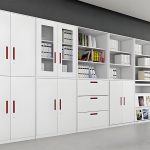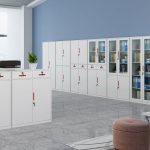For businesses managing office storage, the decision to lease or buy office steel filing cabinets impacts cash flow, flexibility, and long-term costs. This guide breaks down the financial and operational trade-offs to help you choose the smarter option.
1. Cost Breakdown: Lease vs. Buy
| Factor | Leasing | Buying |
|---|---|---|
| Initial Cost | Low to zero down payment | High upfront cost (e.g., 500–2,000 per cabinet) |
| Monthly Expense | 20–100/cabinet (depends on term) | $0 after purchase (except maintenance) |
| Maintenance | Covered by lessor | 50–150/year per cabinet for repairs |
| Upgrade Costs | Easy to swap for newer models | Must sell/dispose of old cabinets |
| Tax Benefits | Lease payments may be tax-deductible | Depreciation deductions over 7–10 years |
Key Insight:
- Short-term projects (1–3 years): Leasing often costs 30–50% less than buying.
- Permanent offices (5+ years): Buying breaks even after 3–4 years and saves more long-term.
2. When to Lease Office Steel Filing Cabinets
Flexibility is critical
- Startups or pop-up offices needing scalable storage.
- Companies relocating frequently (e.g., every 2–3 years).
Cash flow constraints
- Avoid large upfront costs by spreading payments over time.
- Example: A 10-cabinet lease at 50/monthcosts6,000 over 10 years vs. $8,000 to buy outright (including maintenance).
Tech-driven needs
- Lease smart cabinets with RFID tracking or auto-locking features, then upgrade when technology evolves.
Risks of Leasing:
- Long-term leases (5+ years) may exceed purchase costs.
- Penalties for early termination or damage.
3. When to Buy Office Steel Filing Cabinets
Long-term stability
- Established businesses in permanent locations.
- Cost savings: A 1,200cabinetlasts10+yearsvs.3,600 in lease payments over the same period.
Customization needs
- Buy heavy-duty or fireproof cabinets tailored to industry regulations (e.g., HIPAA for healthcare).
Asset ownership
- Resell cabinets for 30–50% of the original price after 5 years.
- Example: Selling 5 used cabinets for 1,800recoupspartofthe6,000 initial investment.
Risks of Buying:
- Obsolescence: Older cabinets may lack modern features like cloud integration.
- Storage costs for unused cabinets during downsizing.
4. The 5-Year Rule: A Simple Decision Framework
Estimate usage duration:
- If <5 years → Lease.
- If ≥5 years → Buy.
Calculate total costs:
- Lease: (Monthly rate × 12 × years) + termination fees.
- Buy: Purchase price + (maintenance × years) – resale value.
Example:
- Lease: 3 cabinets at 75/monthfor5years=13,500.
- Buy: 3 cabinets at 1,500each+450 maintenance = $4,950.
- Savings: Buying saves $8,550 over 5 years.
5. Hidden Costs to Watch For
Leasing pitfalls:
- Auto-renewal clauses that extend leases without notice.
- Fees for normal wear and tear (e.g., scratches).
Buying pitfalls:
- Storage costs for excess cabinets during office redesigns.
- Disposal fees for non-recyclable models (e.g., 50–200 per unit).
6. Industry-Specific Recommendations
| Industry | Recommendation | Reason |
|---|---|---|
| Legal Firms | Buy fireproof cabinets | Compliance with document retention laws. |
| Tech Startups | Lease modular cabinets | Adaptable to rapid team growth. |
| Healthcare | Buy HIPAA-compliant lockable cabinets | Protect patient data long-term. |
| Event Spaces | Lease lightweight cabinets | Easy to reconfigure between events. |
Conclusion: Align Costs with Business Goals
- Lease if you prioritize flexibility, low upfront costs, or frequent upgrades.
- Buy if you seek long-term savings, customization, or asset ownership.





